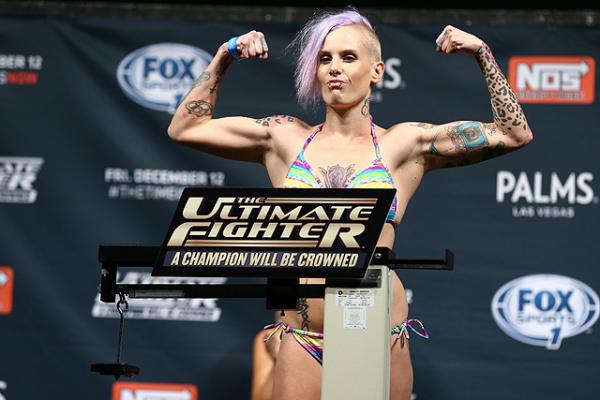With the introduction of the women’s flyweight division in the UFC, we have once again seen a number of fighters who believe the introduction of this weight class will rejuvenate them and get their career back on track.
Some say that it’s a matter of the weight cut that drains them of their speed, their recuperative ability, their conditioning, their punch resistance or their athleticism.
For those who move up, the issue becomes the giants they face and how it essentially makes their athleticism, punching power, durability and conditioning a non-factor because of the huge physical disadvantage they encounter. There is some truth to this. We have seen some examples of very skilled, versatile, seasoned, well-conditioned and athletically talented fighters who suffer one-sided losses to fighters who are only slightly better than them in regards to skills. The larger fighter is able to control, if not outright dominate, the smaller fighter because of the strength and physical advantage that comes from being the naturally bigger fighter. Sometimes fighters are the victims of one-sided beatings from opponents who lack their level of experience or overall craft, for no other reason than the fact they are stronger, harder hitting, and more durable as a result of size.
These fighters are hitting a wall because they are at such huge disadvantages while fighting at a weight class above their optimum weight of effectiveness. They have no margin for error in regards to strategy or execution of technique. A fighter who is operating with no room to err is not a fighter who will be successful. These fighters have enough skill to be a force at a lower weight. Most of them — fighters like atomweights-turned-strawweights Jessica Penne, Jodie Esquibel, Michelle Waterson and Seo Hee Ham — were considered to be elite at their original weight. Three of these four fighters have been world champions at smaller weights. They proved themselves as the best of the best at another division, only to move up and become a fighter whose name far outpaces their in-cage performance. It’s not because of a lack of preparation, dedication, technique, professionalism, skill or IQ, but almost exclusively because of a ridiculous size and strength disadvantage.
Then there are the fighters who think the weight is their only issue. They completely ignore their own one-dimensional skill sets, lack of depth in one or more skill sets, and their overreliance on physical tools or size alone. These fighters aren’t elite. They have routinely been outclassed in regards to technique or cage IQ. They ignore the fact that their striking is one-dimensional (Bec Rawlings), their footwork and setups aren’t efficient or effective (Lauren Murphy), or that they tend to have defensive or strategic lapses that hinder their ability to execute under duress (Rawlings, Murphy and Joanne Calderwood). These fighters aren’t bad fighters. They are good fighters, but none of them have been or were ever considered elite. When they were in with the best opponents, their lack of key skills cost them wins that their level of experience says they should have secured.
That’s not to say that weight didn’t drain Calderwood or Rawlings, thereby impacting their overall performance. That’s not to say the lack of size didn’t limit Murphy’s ability to execute her game plan and play up the strengths she has in regards to IQ and physicality. Based on observation and based on what those fighters have said, this is very likely. However, when Rawlings fought at a higher weight class, her striking was still painfully one-dimensional, her work rate was inconsistent, and her defense and counters only made sporadic appearances. The same could be said of Murphy, whose lack of footwork, limited offensive striking arsenal and poor grappling/striking setups called into question her presence in The Ultimate Fighter 26 house and left more questions than answers after her performance at the TUF 26 Finale.
Fighting at a different weight helped these ladies to a degree. Initially, Rawlings looked more energetic and seemed more active at a higher weight. Murphy’s physicality and pace came more into play at the lower weight. However, the technical limitations and strategic miscues that we have seen from both over the length of their careers at their previous weight classes didn’t change when they fought at a different weight. Essentially, they addressed the symptoms, but not so much the actual problems. Neither fighter looked like a new fighter or a greatly improved fighter. Instead, they just looked like the same fighters in better circumstances — one without a severe weight cut (Rawlings), the other not being in the cage with giants (Murphy). Neither woman showed any standout defensive acumen or awareness. Nor did they show a diversified and particularly nuanced sense of offense or counters. Rawlings’ increase in weight provided nominal benefits. Murphy had a win in the TUF Finale, but she convinced no one that six months from now she will be a major player in the division. While Murphy’s win over Barb Honchak is quite the feather in the cap, the fight only occurred because of a “surprising” loss by Honchak to eventual champion Nicco Montaño who out-quicked, out-slicked, outworked and out-schemed the former Invicta champion in the TUF competition. Many will point to the circumstances, just like many will point to Rawlings’ opponent missing weight. Those things might have played a factor, and to deny this would be ridiculous. However, the biggest factor is the same thing that often plays a role for a fighter of that caliber: skills, or the lack thereof.
Some fighters benefit from dropping or moving weights. We can’t begrudge any fighter their opportunity to extend or improve their career. However, we can’t ignore egregious strategic errors or obvious lack of technical balance and execution. In many cases, the weight isn’t the problem. It’s the fighter.

